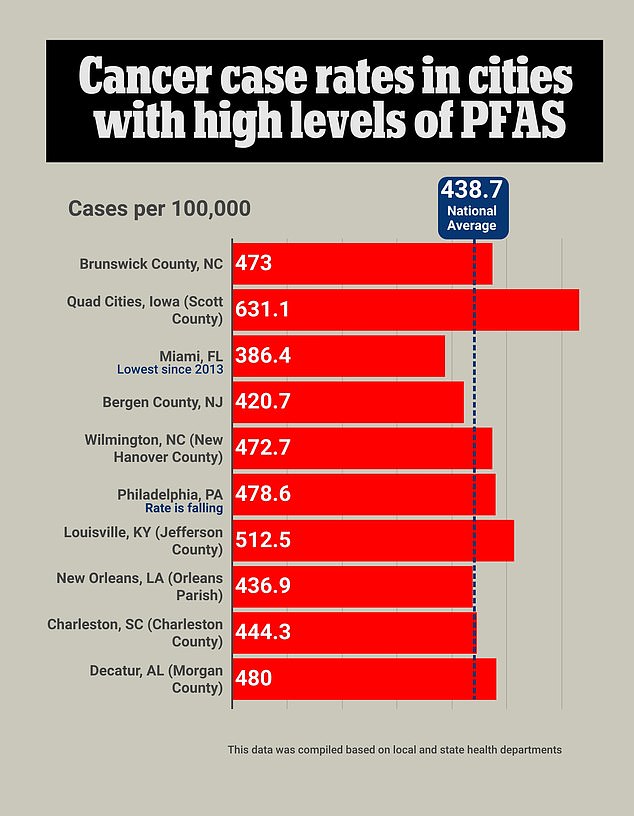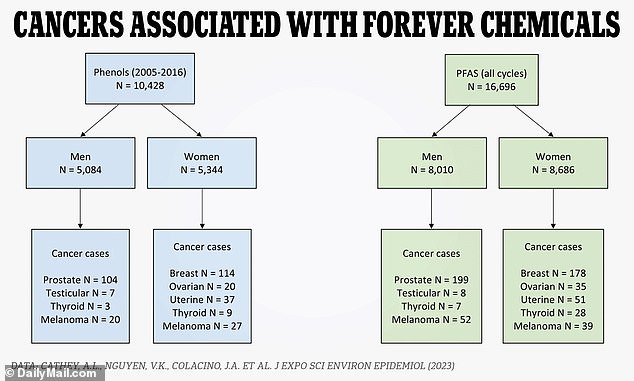PFAS ‘forever chemicals’ found in half of US drinking water DOUBLE risk of cancer in women… but NOT men, study suggests
The toxic “forever chemicals” lurking in nearly half of the drinking water across America pose a far greater health risk to women than to men, a shock study has found.
Scientists have warned for years that tiny man-made PFAS chemicals, found in thousands of household products, can cause a host of diseases and cancers.
However, a recent study is the first to show that PFAS affect men and women differently, putting women at greater risk for cancer.
Results from the study suggest that women with higher exposure to PFAS were twice as likely to report a previous melanoma diagnosis than women in the lowest exposure group.
The study also found a link between PFAS and a previous diagnosis of uterine cancer, and women with higher exposure also had a marginal increase in the risk of previous ovarian cancer.
David Andrews, a senior scientist at the Environmental Working Group, was not involved in the study but reviewed the findings and said more monitoring of contaminated water is needed.
He said: ‘This study adds further evidence to a growing body of scientific research linking exposure to common man-made chemical contaminants with a higher risk of developing cancer.
‘Much more research is needed to ensure that chemicals that affect the endocrine system and change hormone levels do not contaminate our bodies.’
The map compiled by the US Geological Survey shows the number of PFAS detections in a wide range of locations nationwide between 2016 and 2021.

The Environmental Working Group, an activist organization focused on environmental pollutants, has mapped the communities and military sites confirmed to be contaminated with PFAS

PFAS, also called ‘forever chemicals’, have been linked to birth defects and an increased risk of a range of cancers
Researchers did not provide a definitive reason why women were disproportionately affected by environmental PFAS exposure, although they speculated it could be hormone-related, and they stressed that more research into the associations is needed.
The results are particularly concerning because previous studies have shown that a majority of Americans drink water straight from the tap, which may have chemicals added to it.
PFAS are a group of synthetic chemicals found in food packaging, clothing and thousands of other products in the US.
Because of their ubiquity, they leach into soil, drinking water, air and food, exposing Americans to the toxins almost everywhere.
They are considered ‘forever chemicals’ because they do not break down in the environment or the human body and have been linked to birth defects and an increased risk of a range of cancers.
PFAS substances are substances that disrupt the hormone system. This system is responsible for regulating the body’s hormones and all biological processes from conception through old age, including the development of the brain and nervous system and the growth and function of the reproductive system.
The ovaries and testes, as well as the pituitary gland, thyroid and adrenal glands are important components of the endocrine system.
Researchers said their study highlighted that across multiple types of tumors, people with a previous cancer diagnosis had elevated levels of toxins in their bodies. Hormonally caused cancers, such as breast cancer, are often treated with hormone therapy, but exposure to endocrine disruptors, such as PFAS, can make therapies less effective and cause disease progression and recurrence.
For the study, researchers analyzed data between 2005 and 2018 from the US National Health and Nutrition Examination Survey, a research program designed to assess the health and nutritional status of adults and children in the US.
Data was collected from about 27,000 people and looked at the concentrations of seven PFAS and twelve phenols/parabens, types of forever chemicals, in people’s blood and urine samples.
The study did not provide any geographic information about the subjects.
However, a previous study by the US Geological Survey tested water sources from 716 private and public water sources across the country for PFAS and found that 45 percent of drinking water sources contained at least one PFAS.
Based on the data, researchers concluded that faucets in densely populated urban locations generally had higher levels of PFAS than faucets in rural areas of the country.
The greatest concentration was found in the Great Plains, the Great Lakes, the East Coast, and Central and Southern California.
Researchers for the recent study collected cases of self-reported diagnoses of melanoma and cancers of the thyroid, breast, ovaries, uterus, prostate and testicles in men and women over age 20.
Of the substances examined, they found that certain PFAS and phenols/parabens were associated with higher rates of certain cancer diagnoses.
Previous melanoma diagnoses in women were seen in women exposed to six types of PFAS. Previous ovarian cancer was seen in women exposed to three types of PFAS, while previous uterine cancer was associated with one PFAS.
Two other PFAS, known as PFNA and PFUA, had almost double the odds of a previous melanoma diagnosis.

Of the substances studied, they found that certain PFAS and phenols/parabens were associated with higher rates of certain cancer diagnoses
The study found no link between PFAS and previous diagnoses in men.
In the group of people exposed to phenol and parabens, researchers observed a melanoma diagnosis in 20 men and 27 women and a thyroid cancer diagnosis in three men and nine women.
Prostate cancer was seen in 104 men and breast cancer in 114 women.
Twenty women were diagnosed with ovarian cancer and 37 women were diagnosed with uterine cancer.
In the other PFAS-exposed groups, melanoma was observed in 52 men and 39 women and thyroid cancer in seven men and 28 women.
Thirty-five women had ovarian cancer, 51 had uterine cancer and 178 had breast cancer. Of the men, 199 had prostate cancer.
There were also racial differences. White women were more likely than black women to be diagnosed with ovarian and uterine cancer earlier, and white men with PFAS exposure were more likely than black men to be diagnosed with prostate cancer earlier.
The study was published Monday in the Journal of Exposure Science and Environmental Epidemiology and was led by researchers from the University of California San Francisco, University of Southern California and University of Michigan.
